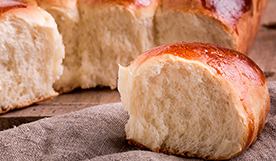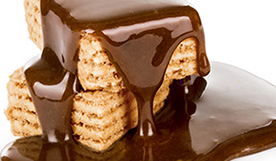Product Emulsifiers.
Product range available:
- PANODAN® DATEM(Diacetyl Tartaric Acid Esters)
- DIMODAN® Distilled Monoglycerides
- GRINDSTED®MONO-DI
- GRINDSTED® SSL (Sodium Stearoyl Lactylates)
- GRINDSTED®CSL (Calsium Stearoyl Lactylates)
- GRINDSTED®PGPR (Polyglycerol Polyricinoleates)
- GRINDSTED® PGE (Polyglycerol Esters)
- GRINDSTED® PGMS (Propylene Glycol Esters)
- GRINDSTED® SMS (Sorbitan Monostearates)
- GRINDSTED® STS (Sorbitan Tristearates)
- GRINDSTED®LACTEM (Lactic Acid Esters)
- GRINDSTED®CITREM (Citric Acid Esters of Monoglycerides)
- GRINDSTED®Crystalliser (Emulsifier Blends)
- GRINDSTED® PS (Emulsifier Blends)
- GRINDSTED® OX (Emulsifier Blends)
Emulsifiers are composed of molecules with a hydrophilic end and a lipophilic end. They function as the interphases between phases of different polarity found in many food products in many categories such as oils & fats, dairy, bakery, confectionary, etc. Moreover, some emulsifiers have a specific affinity for certain food ingredients.
Because of the fat-emulsifying and gluten-complexing effects of the emulsifier, it offers a number of benefits in the production of baked goods. Firstly, it will increase dough stability and, in consequence, the dough will be less sensitive to shocks during mechanical handling and proving. Next, better gas retention, together with the lubricating effect of the emulsifier, will sustainably increase the volume of the dough and therefore of the finished products.
The use of emulsifiers (especially in bakery application) provide these following further benefitsderived, include:
- Provide a more homogeneous and softer crumb structure (where lecithin and soya oil lack of this properties), improves crispness, crust colour, and reduce stickiness in the mouth
- Provide lower viscosity and increases through-put by changing the gelatinisation process and elastic properties of protein
- Obtaining improved fat emulsification and reducing the fat content of biscuits without reducing their quality
- Improve the softness and chewiness
- Better dough, easier to release from the scoop
- More baked goods per batch of dough
- Better water retention
- Extend shelf-life
Undeniably, emulsifiers are indispensable in the application of making different types of products, including:
| Application | Function of emulsifier |
|---|---|
| Bakery: biscuits, cake, dough, filling, crackers, wafers, extruded snacks, soft cookies | Antistaling, improved volume & dough stability, improved emulsification – fat reduction, improved crumb structure & cake volume |
| Oils & fats: frying margarine, butter, spreads, tin grease emulsions | Emulsion stabilisation, anti-spattering, anti-crystalliser, prevent oiling out, excellent release properties |
| Cake margarine | Improvedaeration & stability of cake batter, reduce sandiness, increased performance |
| Dressings | Emulsion stabilisation |
| Dairy: neutral milk, acidified milk, yogurt, cheese & processed cheese | Milk mouthfeel |
| Dairy & non-dairy cream | Increased whippability |
| Coffee whitener | Feathering stability and improved whiteness |
| Confectionary: candy, chocolate compound, paste, and spreads | Alternative to lecithin, anti-bloom agent, yield stress reduction, emulsion stabilisation |
| Dessert: ice cream | Emulsion de-stabilisation |
| Meat emulsions | Reduces fat separation |
Emulsifiers may be used wherever an oil-in-water emulsion is required.

Variety bread is becoming increasingly popular in many countries as a result of increasing awareness of the nutritional importance of fibre. Consumers are interested in supplementing white bread with types of bread that have a new, different taste. Bread with containing wheat combined with whole wheat is very popular, but multigrain bread has also gained increasing consumer acceptance because it possible to enrich and vary the taste of bread. Seeds and fibre, however, make great demands on the gluten network of dough. Consequently, it necessary to stabilise and improve the gluten, and for this reason bread improvers are very often used in the production of variety bread.
In variety bread, the emulsifier has demonstrated its ability to provide an extremely good dough strengthening effect. In other words, the emulsifier helps produce a dough with improved stability and tolerance when exposed to rough handling. The improved stability also influences the finished loaf and leads to the production of better bread with a softer crumb and a nice crust. The improved softness also explained by the increasing volume of bread by 20-25%.

DIMODAN® has a specific affinity for starch, while PANODAN® interact with proteins. These emulsifiers have a dual role in the processing extruded foods based on starch-containing raw material.
As functional ingredients, emulsifiers provide a higher degree of uniformity in the end product by controlling starch gelatinisation and expansion.Ouravailable emulsifier products provide a more homogeneous structure (where lecithin and soya oil lack of this properties), improves crispness, and reduce stickiness in the mouth.
As processing aids, emulsifiers reduce pressure provides and energy consumption and improve extruder capacity by lubricating the system. Our available emulsifier products provide lower viscosity and increases through-put by changing the gelatinisation process and elastic properties of protein.

One of the reasons for the popularity if biscuits is their good taste properties and long storage stability. In types of biscuits that contain high levels of fat it has been demonstrated that the use of emulsifiers is an advantage with a view to obtaining improved fat emulsification and reducing the fat content of biscuits without reducing their quality. The fat content of short-dough biscuits can be reduced by 20-30% when emulsifiers are added. This reduction is desirable from both a nutritional and an economical point of view.

Soft cookies have gained popularity as a delicate snack. Emulsifier can effectively improve the softness and chewiness in soft cookies. After one-month, soft cookies containing emulsifier with dosage of 4-6%, remained soft and chewy. Furthermore, there are more effects of emulsifier in soft cookies:
- Better dough, easier to release from the scoop
- More homogeneous crumb
- Better water retention

Small doses of GRINDSTED® PGPR are effective means of reducing the yield value and cost of chocolate. A low yield value is particularly desirable in chocolate formed into complicated shapes, such as hollow eggs and other hollow chocolate products, chocolate-coated products, and chocolate bars with nuts. For these complicated shapes and thin chocolate coatings, GRINDSTED® PGPR is ideal, ensuring the low yield value and easy-flowing chocolate essential to successful processing. GRINDSTED® PGPR also makes it possible to mould fruit and nut chocolate with a fat content less than 30% which reduces costs.
Organoleptic quality is tested by measuring the maximum dosage of GRINDSTED® PGPR that can be added without causing an off-taste. Other following benefits can be obtained when GRINDSTED® PGPR is added to dark and milk chocolate:
- Cost savings
Around 4-6% fat can be saved while maintaining the same yield value. In combination with lecithin, GRINDSTED® PGPR reduces flow properties to the same low level as when using a high fat content. - More convenient processing
The reduction in yield value makes chocolate easier to handle, for example, in pipelines, during tempering and enrobing/moulding. -
Water absorption
The yield value remains at a low level during water absorption, making chocolate suitable for coating ice cream. -
Moulded products
Air bubbles can be more easily removed from chocolate bars, such as those containing nuts, by using the vibration belt prior to the cooling tunnel. -
Enrobed products
Products can be coated with a very thin, uniform layer of chocolate. -
Hollow products
The low yield value is very important when forming chocolate into complicated shapes, such as hollow eggs, chocolate shells for filled products, etc.






